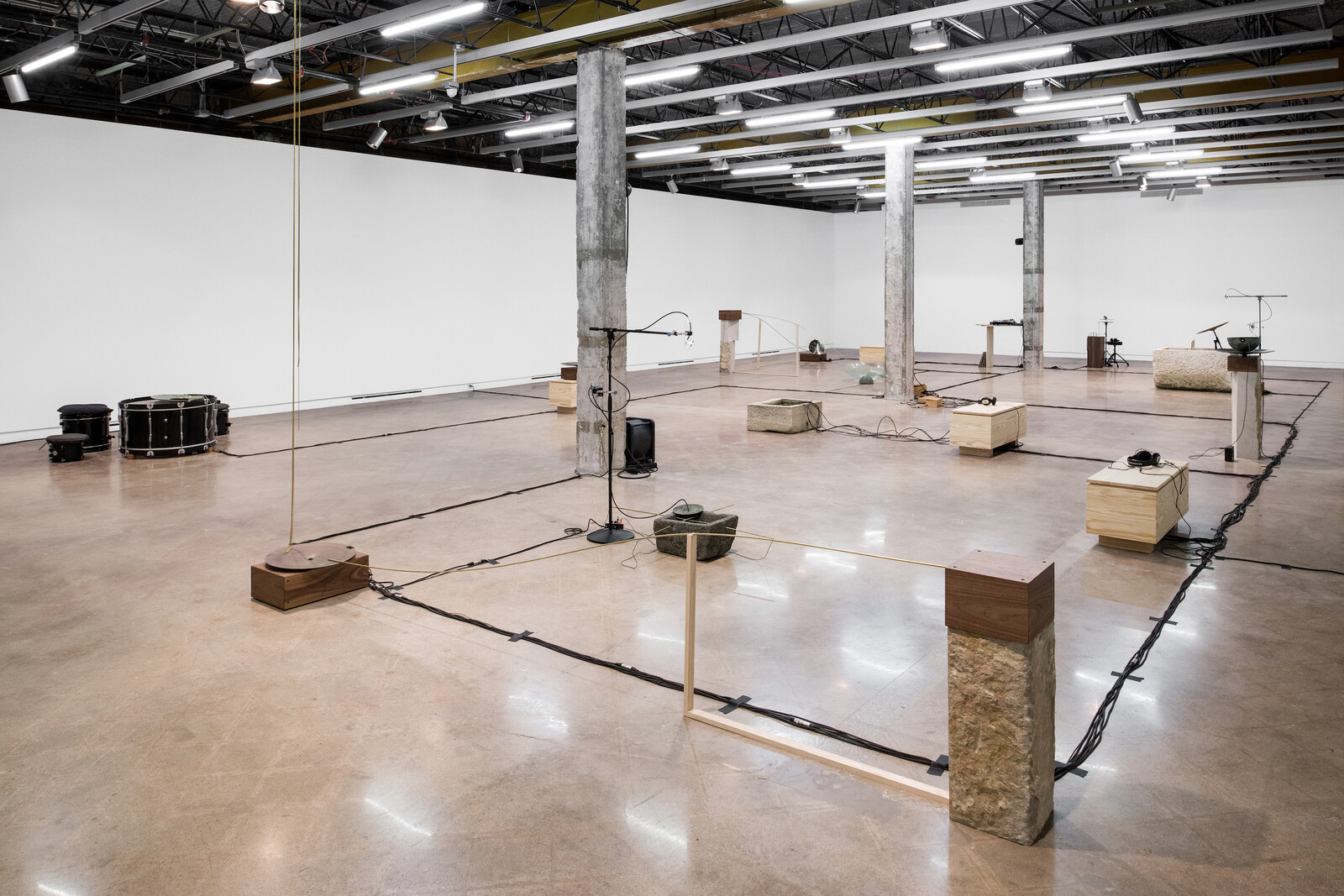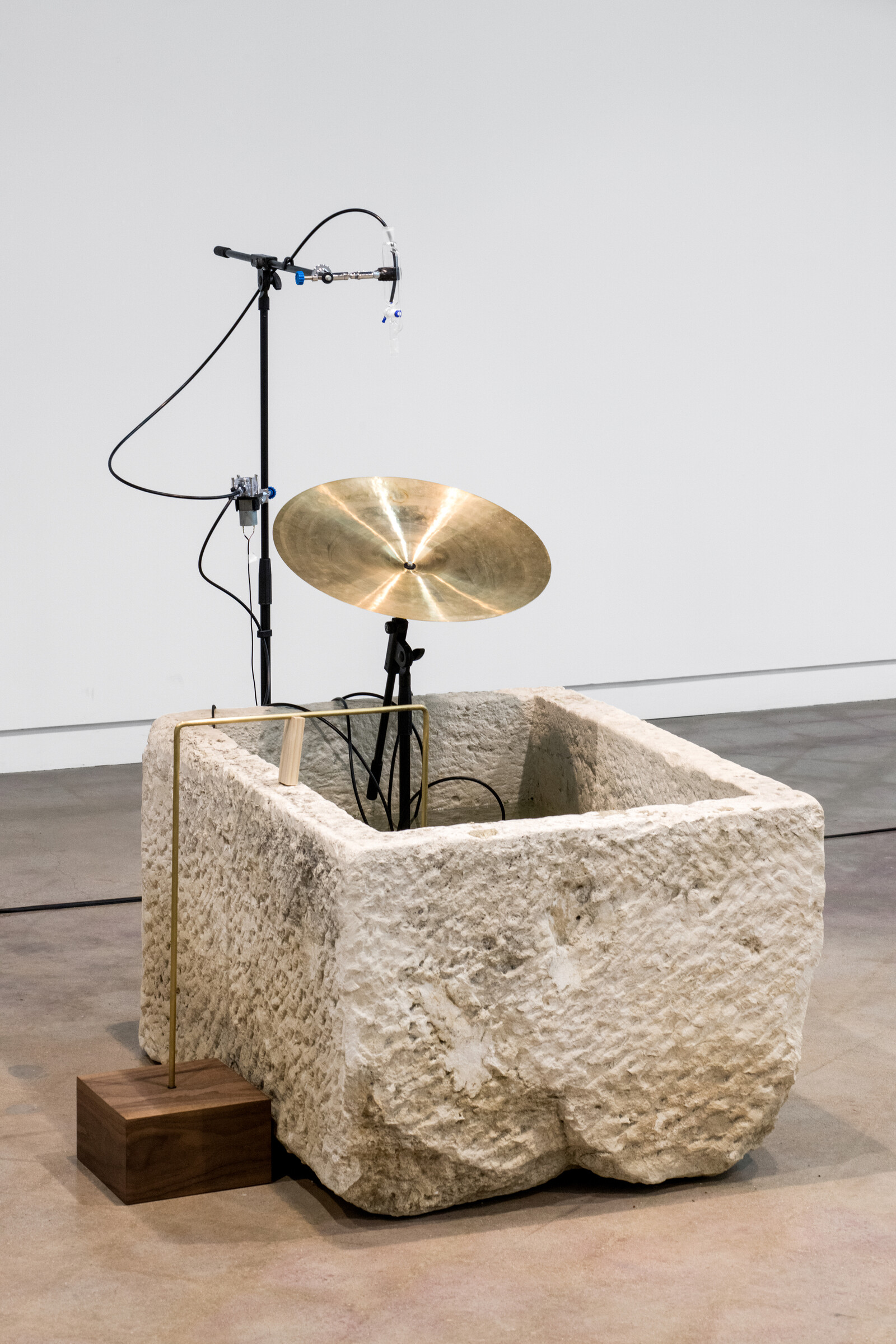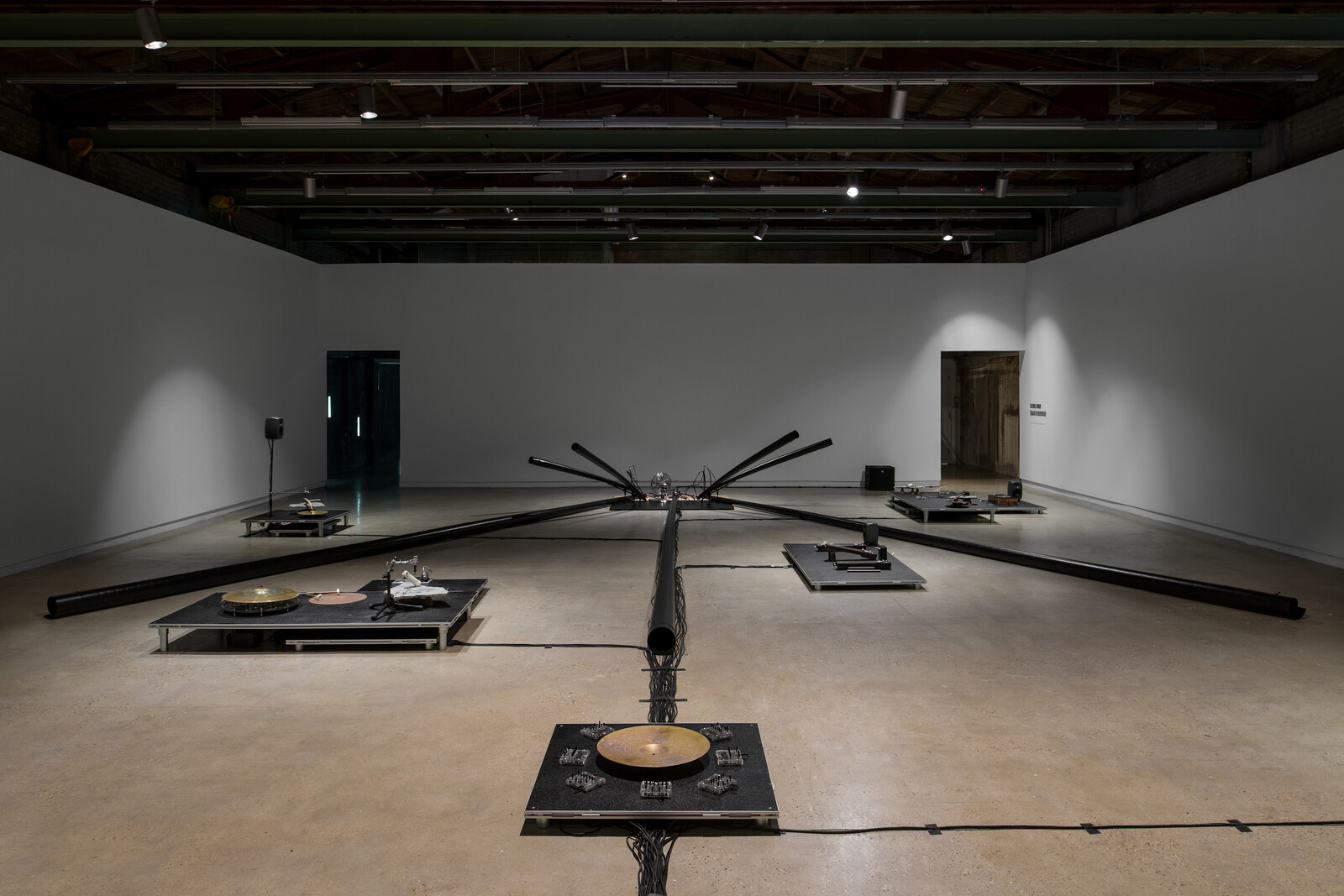Near the entrance of the Contemporary’s street-level gallery, a long chain hanging from the ceiling rigging traces a circular motion around an oxidized cymbal. In the sculptural assemblage The Whisperers: Infinite Ballet Solo (2020–21) these pieces are connected via a long brass rod to a wooden box perched atop a concrete pedestal, and to other nearby elements. The mesmeric, metallic rub and scrape generated by the chain’s slow trajectory is miked, and can be isolated if listened to in headphones nearby, but it’s just as audible at the other end of the gallery, where it coalesces into the overarching din of the soundscape.
Tarek Atoui’s exhibition “The Whisperers” is a meticulously orchestrated playground in which each “tool for listening,” as he calls them, triggers a mechanism that generates a series of chain reactions and feedback effects. These new sculptures, first exhibited at Galerie Chantal Crousel in Paris last year, emerged out of a collaboration with a class of kindergarten students on an ongoing sound workshop. They conserve their experimental, ludic quality with playful titles given for the form each assemblage evokes, or the associations it whimsically stirs up. Underwater Birds (2020–21), for instance, fosters a set of aquatic plants, while the bubble system in the cistern containing them emits a continuous stream of fizzy substance at the surface of the water. These titles don’t say much about the precise mechanics of each sculptural instrument, nor do they encompass the full range of materials at play. Indeed, the materials lists for each work are long, attesting to a constructivist principle at the core of Atoui’s work: materials are studied, exploited, manipulated, experimented with, and networked, according to their inherent acoustic properties. Wood, air, water, brass, bronze, and stone become the syntactic units of an open-ended sonic sentence made of dense, long clauses. List commas in the captions are poor substitutes for such complexity.
At the far end of the gallery, Home (2020–21) channels all of these registers. Visitors can select LPs sourced locally by the artist and curator Robin K. Williams to play on a record player, with an input that travels through a brass conductor into a stone cistern hosting a pool of water, whose continuous, organic drip is amplified with a mic. A connected Mac mini control station mixes two other layered tracks: an electro-acoustic composition by the artist, and field recordings taken at harbors in Abu Dhabi, Singapore, Porto, and Beirut. The confluence of inputs and outputs and their respective, mutual effects is dizzying. Natural stimuli are siphoned through various conductors only to emerge—modulated and reconstituted—elsewhere in the space, in another form, through another sound device. Cause and effect are occasionally cast into relief, but are also just as easily obscured. “The Whisperers” welcomes scrupulous attention and provokes the urge to trace the origins of effects of materials upon one another, but this is soon dispelled by the sheer impossibility of the task and the pleasure of shuttling between immanent event and total effect.
These sculptures—circuits of interplay between elemental and programmed sounds—remind us that unpredictability and natural variation are built into even the most complexly contrived structures, and they invite us to slow down—a welcome proposal. An unremitting water drip becomes a timekeeper, but the irregularity of its spurts remains idiosyncratic. In their construction and connectivity, Atoui’s “Whisperers” might evoke a lineage of systems art that includes the ecological projects of Helen Meyer and Newton Harrison, for instance, or the works of Hans Haacke focused on the observation of biological processes in physical space. Atoui’s sonic ecosystem takes scales of interdependency, autonomy, and feedback as its core principles, while eschewing the more timeworn association, at least in the experimental music context, with Cagean precepts of chance and indeterminacy.
On opening weekend, local Austin musicians, who had spent months engaged in an ongoing study of the component parts of these instruments, activated “The Whisperers”’ possibilities in an hour-long performance that dramatized the installation’s intended participatory nature. Chris Cogburn staged one-to-one recitals based on scripted protocols handed out to audience members; Parham Daghighi worked directly with MIDI, effecting adjustments to the interface that connects to the installation’s underlying program and routes all its inputs and outputs; while Henna Chou, more often than not, paused to listen. Performing the kind of attention Atoui’s work generally invites, she executed micro-actions attuned to the slightest of shifts effected by her colleagues.
The black box on the second floor mines the possibilities of a more permanent, theatrical presentation with The Wave (2019), which functions as a compilation of older works, including WITHIN (2012–16), The Reverse Sessions / The Reverse Collection (2016), and The Ground (2017–18). Unlike downstairs where, as Atoui remarked in conversation, there is mystery, upstairs is more didactic: “What you see is what you hear” (though I’d argue you’d have to have a highly trained eye and ear to confidently agree). In The Reverse Sessions, for instance, Atoui worked with ancient instruments in the collection of the Berlin-Dahlem Ethnological Museum, and a vast network of collaborators. Guided only by recorded improvisations on these instruments, and without any visual referents, instrument-makers from around the world worked intuitively to construct new objects from available materials and technologies that could best approximate the sounds they had heard. WITHIN, which resulted from Atoui’s long-term work with deaf children, expanded accessibility to modes of listening by emphasizing the somatic and vibrational dimensions of sound—a project that is completed downstairs in the Drum Club, which Cogburn used in an experimental lab phase preceding the exhibition with students at the Texas School for the Blind and Visually Impaired.
As distinct as each floor feels, it’s difficult to delineate any one body of work in the exhibition because of the open-ended nature of each project, and the ways in which it might be redeployed or activated anew for a new exhibition or venue. The work is never done, it is merely put to rest when the artist has determined that the research that informs it has reached a limit. Atoui’s “discrete” works are anything but: they cross-contaminate at the level of ideation and conception; are iterative in their realizations, and porous in their authorship, which is co-produced by the artist, his collaborators, and to some extent, the public. Everything has the potential to continue to develop, be instructive, and be pushed further. Atoui’s presentation here amounts to a radical proposal, wherein sound’s permeability offers up a space for pedagogy and experimentation, collaboration and exchange.


